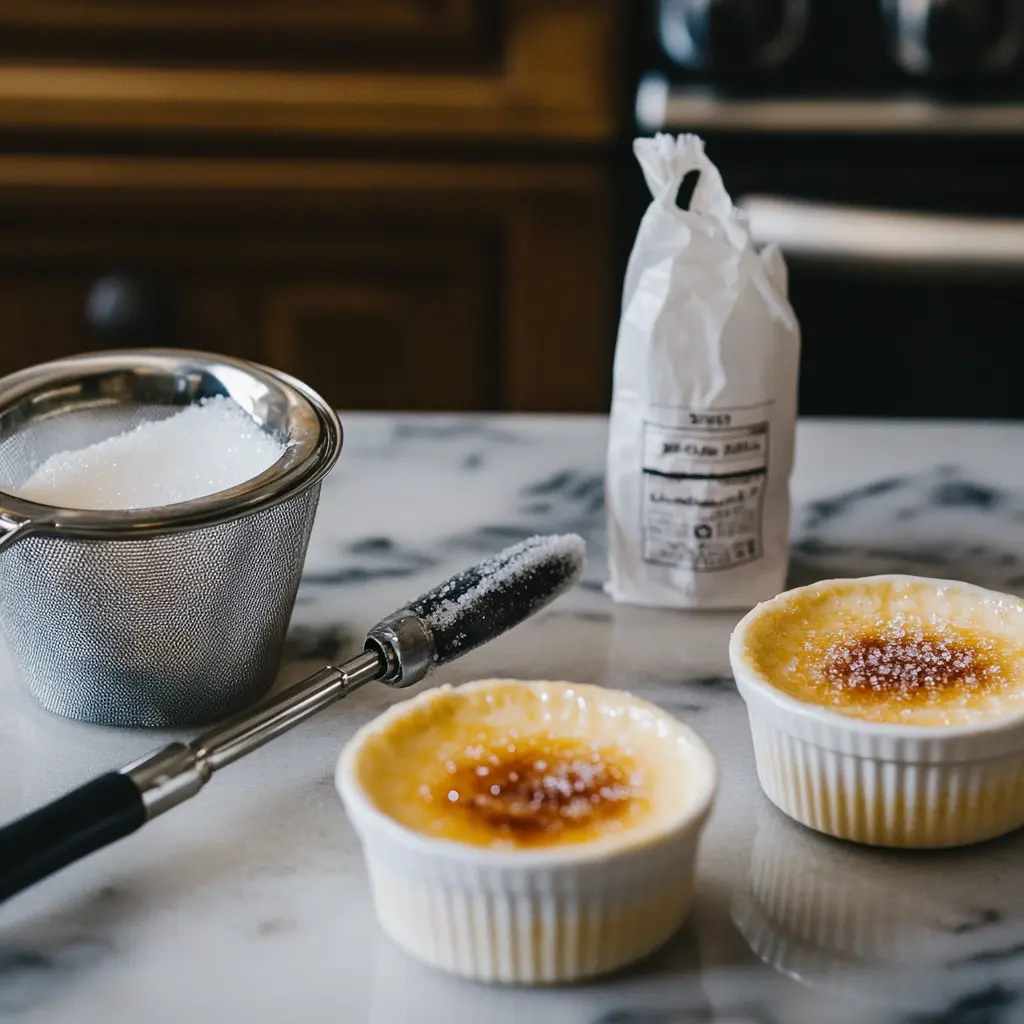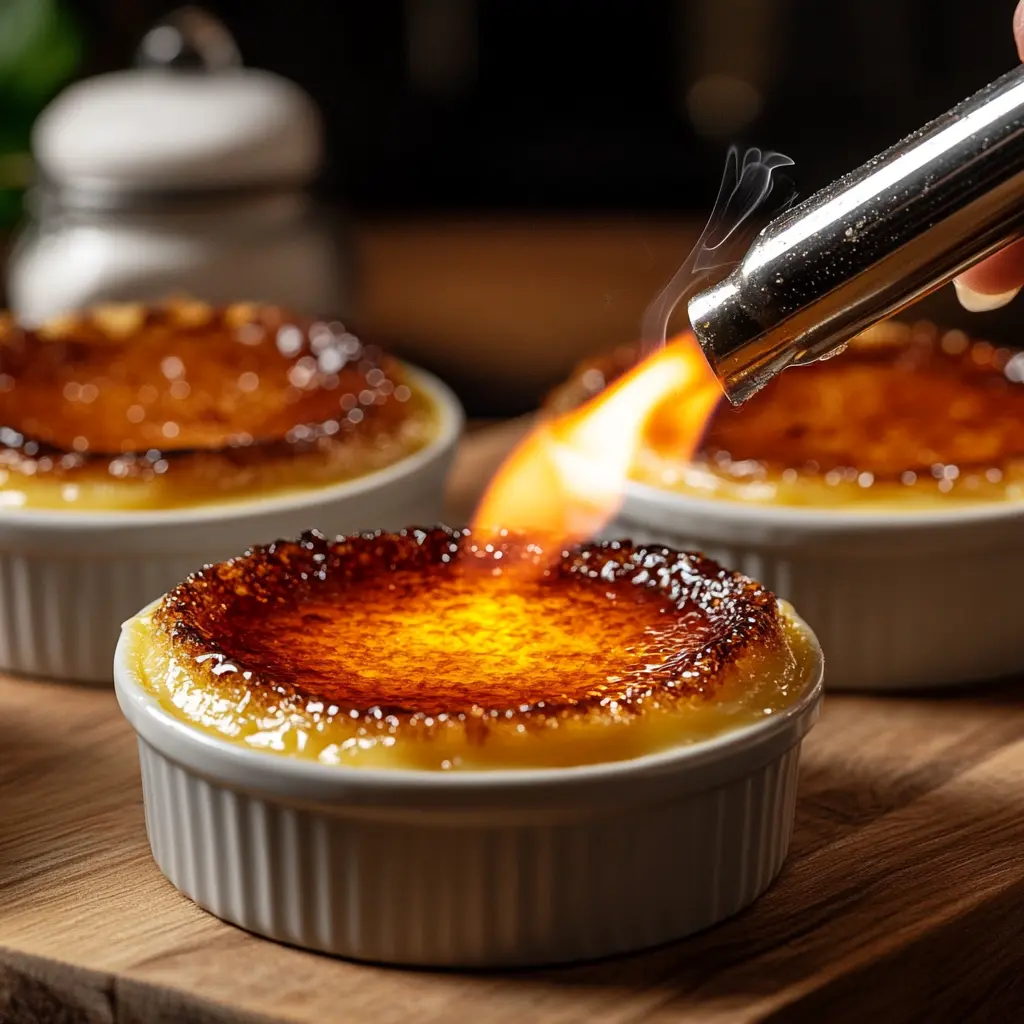Crème brûlée, a timeless classic in the world of desserts, boasts a velvety custard base capped with a perfectly caramelized sugar crust. The interplay between the creamy texture and the brittle, sugary topping is nothing short of magical. But achieving that delicate balance? It’s an art form. This guide dives deep into the nuances of how to caramelize brûlée to perfection. From selecting the ideal sugar to mastering caramelization techniques, let’s transform this culinary delight into a crowd-pleasing masterpiece.
Part 1: Understanding Crème Brûlée
Origins and History of Crème Brûlée
The story of crème brûlée is as rich as its flavor. Often traced back to 17th-century France, this dessert has its roots in elegant European dining traditions. The name itself translates to “burnt cream,” a nod to the caramelized topping. While its exact origins remain a topic of debate, one thing is certain: its popularity has only grown over centuries. Today, it stands as a symbol of sophistication and culinary craftsmanship.
The Significance of Caramelization in Crème Brûlée
Caramelization is the pièce de résistance of crème brûlée. It’s not just about the golden-brown hue but also the crunch that harmonizes with the creamy custard below. The caramelization process transforms simple sugar into a complex flavor profile—ranging from toasty to subtly bitter—adding a sensory delight to every bite. Skipping this step would render the dessert incomplete, robbing it of its signature allure.
Part 2: Essential Ingredients for Caramelizing Brûlée
Selecting the Right Sugar for Caramelization
The type of sugar you choose for caramelizing crème brûlée plays a pivotal role in achieving that signature crunchy topping. Granulated white sugar is the gold standard—it melts evenly and caramelizes into a perfectly golden crust. While brown sugar adds a molasses-like flavor, it tends to burn quickly and might not provide the crispness desired. To get the best results, opt for a fine grain that spreads easily but isn’t powdered, ensuring uniform caramelization.
For those who love experimenting, superfine sugar can be a good alternative. Its smaller granules ensure even melting and create a smoother crust, perfect for enhancing the brûlée experience. However, avoid using raw sugars, as their coarser texture can lead to uneven caramelization and a gritty bite.
Choosing Quality Dairy and Flavorings
The custard base is the heart of crème brûlée, and quality ingredients are essential. Start with full-fat cream—it ensures the custard is rich and indulgent. While whole milk can be used as a substitute, it might compromise the dessert’s signature creaminess.
For flavorings, vanilla reigns supreme. Fresh vanilla beans offer the most aromatic and authentic taste, with their tiny seeds flecking the custard beautifully. Alternatively, pure vanilla extract is a convenient option. Beyond vanilla, you can explore other subtle flavors like orange zest or a hint of cinnamon to elevate the custard without overshadowing its simplicity.
Part 3: Necessary Tools and Equipment
Culinary Torch vs. Broiler: Which Is Better?
When it comes to caramelizing crème brûlée, a culinary torch is the preferred tool of professionals and home cooks alike. Its precise flame allows you to melt and caramelize sugar evenly, giving you control over the process. With a torch, you can achieve that signature golden-brown crust without overheating the custard beneath.
However, if a culinary torch isn’t an option, a broiler can be a worthy substitute. The broiler’s high, direct heat caramelizes sugar effectively but requires extra attention. Place the ramekins on a baking sheet, position them under the broiler, and keep a close watch—overcooking happens in the blink of an eye. While effective, broilers might not offer the same precision as torches, making it trickier to avoid overly burnt spots.

Additional Tools for Perfect Caramelization
Beyond the torch or broiler, a few essential tools make the caramelization process seamless.
- Heatproof Ramekins: These individual-serving dishes not only withstand high heat but also distribute it evenly, ensuring the custard stays cool during caramelization.
- Fine-Mesh Sieve: Straining your custard mixture before baking removes air bubbles and impurities, resulting in a silky smooth texture.
- Offset Spatula or Spoon: Use these to spread sugar evenly across the custard surface, ensuring consistent caramelization.
- Kitchen Thermometer: This tool is indispensable for cooking the custard to the perfect set-point (around 160°F to 175°F), guaranteeing a creamy base.
Part 4: Step-by-Step Guide to Caramelizing Crème Brûlée
Preparing the Custard Base
The journey to perfect crème brûlée begins with a flawless custard base. Start by whisking together egg yolks and sugar until the mixture turns pale yellow. Gradually add warm cream infused with vanilla, whisking gently to avoid creating air bubbles. Strain the mixture through a fine-mesh sieve into ramekins for the smoothest texture.
Place the ramekins in a baking dish and pour hot water halfway up the sides, creating a water bath. This method ensures even cooking, preventing the custard from curdling. Bake in a preheated oven at 325°F until the custard is set but slightly jiggly in the center, usually 30-40 minutes. Let it cool to room temperature, then refrigerate for at least 4 hours or overnight.

Applying the Sugar Layer Evenly
Once the custard is chilled, sprinkle a thin, even layer of sugar over the surface. About 1 to 2 teaspoons per ramekin is usually sufficient. Gently tilt and rotate the ramekin to distribute the sugar evenly. An even layer ensures uniform caramelization, preventing hot spots that can burn too quickly.
Caramelizing the Sugar: Techniques and Tips
Now comes the most exciting step—turning that sugar into a delectable crust. If using a culinary torch, hold it at a slight angle, about 2-3 inches above the sugar. Move the flame in a circular motion to evenly caramelize the sugar, watching as it melts, bubbles, and turns golden-brown.
For a broiler, place the ramekins under high heat for 1-3 minutes, rotating the tray halfway through if needed. Keep a watchful eye; sugar can go from perfectly caramelized to burnt in seconds. Let the brûlée rest for a few minutes after caramelization to allow the sugar to harden into a crackly crust.
Part 5: Alternative Caramelization Methods
Using a Broiler for Caramelization
If a culinary torch isn’t available, the broiler method is a reliable alternative. Start by preheating the broiler to its highest setting. Position your ramekins on a baking sheet to make handling easier. Sprinkle an even layer of sugar over the chilled custard, ensuring it covers the surface completely.
Place the ramekins about 4-6 inches from the heat source. The key is to monitor closely—sugar can caramelize unevenly or burn quickly under intense heat. Rotate the sheet halfway through for uniform caramelization. Once the sugar bubbles and turns golden-brown, remove the ramekins and let them cool slightly before serving. This method requires patience and precision, but it can yield a delectable crust.
Exploring Other Heat Sources
For those who enjoy experimentation, there are creative ways to caramelize brûlée without a torch or broiler.
- Iron Brûlée Discs: These are heated on a stovetop until red-hot, then pressed onto the sugar layer. This old-fashioned technique produces a consistent crust but requires practice to avoid overcooking.
- Cast-Iron Skillet Method: Sprinkle sugar on a non-stick skillet, heat until it liquefies, and pour the molten caramel over the custard. While unconventional, this method works in a pinch.
Each method offers unique advantages, allowing you to adapt based on your available tools and preference.
Part 6: Common Mistakes and How to Avoid Them
Over-Caramelization Leading to Bitterness
One common pitfall when caramelizing brûlée is taking the sugar too far. Over-caramelization results in a bitter taste that overwhelms the custard’s delicate flavor. To avoid this, stop caramelizing as soon as the sugar turns an amber-brown hue.
Using a culinary torch gives you more control over this process, but if you’re using a broiler, remove the ramekins promptly once the sugar bubbles and browns evenly. Remember, it’s better to under-caramelize slightly than to risk burning the sugar.
Uneven Sugar Layers and Their Impact
An uneven sugar layer can lead to hot spots during caramelization, resulting in inconsistent texture and flavor. Always sprinkle the sugar evenly across the surface and tilt the ramekin to fill in any gaps. Avoid using too much sugar—it should coat the custard lightly, not form a thick mound.
Additionally, if your sugar crust cracks unevenly, it’s often due to a poorly distributed layer. Take time to ensure the sugar is smooth and even before applying heat.
Part 7: Advanced Techniques for Caramelizing Brûlée
Infusing Flavors into the Sugar Topping
For a creative twist, try infusing your sugar layer with subtle flavors. Mix granulated sugar with finely ground spices like cinnamon, nutmeg, or even cardamom for a unique aroma. Alternatively, you can incorporate a touch of citrus zest or a dash of espresso powder to complement the custard’s richness.
Spread the flavored sugar as you would plain sugar, ensuring it’s even. The added elements will caramelize alongside the sugar, creating a flavorful crust that elevates the entire dessert.
Achieving Different Textures in the Caramel Crust
While a smooth, crackly crust is the standard, you can experiment with varying textures. For instance, using coarser sugar like demerara or turbinado can result in a thicker, crunchier crust. If you prefer a delicate finish, superfine sugar provides a thinner, more refined layer.
Another advanced technique involves double caramelization. After the first layer has cooled, sprinkle a second layer of sugar and caramelize again. This creates an ultra-thick, glass-like crust that’s both dramatic and delightful to crack.
Part 8: Pairing Crème Brûlée with Complementary Desserts
Serving Suggestions to Enhance the Experience
Crème brûlée is undeniably a star on its own, but pairing it with complementary elements can elevate its presentation and flavor. The key is to balance the rich, creamy custard and the crisp caramelized sugar with lighter or contrasting textures.
- Fresh Fruits: Berries like raspberries, blueberries, or sliced strawberries add a burst of freshness that cuts through the brûlée’s richness. Their natural acidity complements the sweet custard perfectly.
- Crispy Biscotti or Cookies: Serve your brûlée alongside thin, crisp biscotti or shortbread cookies. These provide an extra crunch without overshadowing the dessert’s delicate flavors.
- Sorbet or Gelato: A small scoop of tangy sorbet, such as lemon or passion fruit, offers a refreshing contrast to the brûlée’s creamy decadence. Gelato, especially in complementary flavors like vanilla or pistachio, can also enhance the experience.
For a more luxurious touch, garnishing with edible flowers or a light drizzle of caramel sauce can elevate the dish visually and tastefully, making it worthy of any occasion.
Part 9: Frequently Asked Questions
Can You Caramelize Crème Brûlée Without a Torch?
Yes, caramelizing crème brûlée without a torch is entirely possible. The most common alternative is using a broiler, which can achieve similar results when managed carefully. Simply preheat your broiler to its highest setting, sprinkle an even layer of sugar on the custard, and place the ramekins a few inches beneath the heat source. Keep a close eye to avoid burning, as sugar caramelizes quickly under high heat.
Another option is the old-fashioned brûlée iron or creating a molten caramel layer in a skillet. While these methods require additional steps, they can replicate the desired effect without specialized tools.
What Type of Sugar Is Best for Caramelizing Brûlée?
Granulated white sugar is the best choice for caramelizing crème brûlée. It melts evenly and caramelizes smoothly, producing a glossy, crackling crust. Alternatives like superfine sugar are also effective and create a slightly more refined finish. However, avoid powdered or raw sugar, as they may caramelize unevenly or result in a gritty texture.
How Do You Prevent the Custard from Overheating During Caramelization?
The key to preventing custard from overheating lies in maintaining a firm, chilled base before caramelizing the sugar. Always refrigerate the custard for at least 4 hours before applying heat. When using a culinary torch, keep the flame moving to avoid focusing heat on a single spot. For broiler users, ensure the ramekins are placed in a water bath or monitor the heat source closely to avoid prolonged exposure.
Frequently Asked Questions
How to Caramelize Crème Brûlée?
To caramelize crème brûlée, start by sprinkling a thin, even layer of granulated sugar over the chilled custard. Using a culinary torch, apply a steady flame while moving in circular motions across the sugar layer. This technique ensures the sugar melts evenly and transforms into a golden-brown crust. If using a broiler, place the ramekins under high heat, monitoring closely to achieve the desired caramelization without burning. Let the brûlée cool briefly after caramelization to allow the crust to harden.
What Is the Best Way to Caramelize Sugar?
The best way to caramelize sugar is by using a culinary torch. It provides precise control over heat, allowing you to evenly melt and brown the sugar without affecting the custard. Start with a fine layer of granulated sugar and caramelize it in small, circular motions to achieve an even, glossy crust. If a torch isn’t available, a broiler can be a great alternative, provided you monitor the process to avoid burning.
How to Caramelize Crème Brûlée Without a Blowtorch?
Caramelizing crème brûlée without a blowtorch can be done using a broiler or stovetop methods. For the broiler, preheat it to high and place the sugar-coated custard under the heat source for 1-3 minutes, watching carefully as the sugar melts and browns. Alternatively, you can caramelize sugar in a non-stick skillet until it liquefies and pour the hot caramel over the custard. Ensure the custard is cold to prevent it from overheating during this process.
Can You Caramelize Crème Brûlée with a Lighter?
While it is technically possible to caramelize crème brûlée with a lighter, it’s not recommended. A standard lighter doesn’t produce enough heat to caramelize sugar evenly and may leave patches of burnt sugar or an undercooked crust. Additionally, lighters can be unsafe for prolonged use in culinary applications. If a blowtorch isn’t available, opt for a broiler or other methods for safer and more consistent results.
Part 10: Conclusion – Mastering the Art of Caramelizing Crème Brûlée
Caramelizing crème brûlée is both an art and a science, transforming a simple custard dessert into a luxurious masterpiece. By understanding the importance of quality ingredients, the right tools, and precise techniques, anyone can achieve that perfect golden-brown crust. Whether using a culinary torch, a broiler, or creative alternatives, the process of caramelization elevates this classic dessert to new heights.
Avoid common mistakes like uneven sugar layers or over-caramelization to ensure your brûlée is as delightful to crack into as it is to savor. Once mastered, the contrast between the creamy custard and the crispy sugar crust will make every bite a moment to remember. Experiment with advanced techniques or pairings to personalize your crème brûlée, and enjoy the satisfaction of creating a dessert that’s sure to impress.
Now, it’s time to put your skills to the test and create the ultimate crème brûlée that dazzles with every spoonful!

